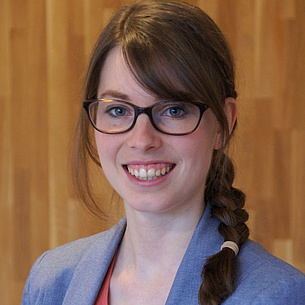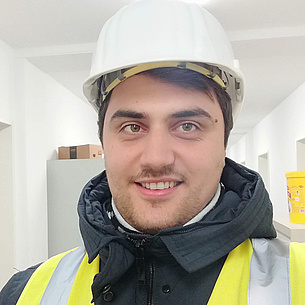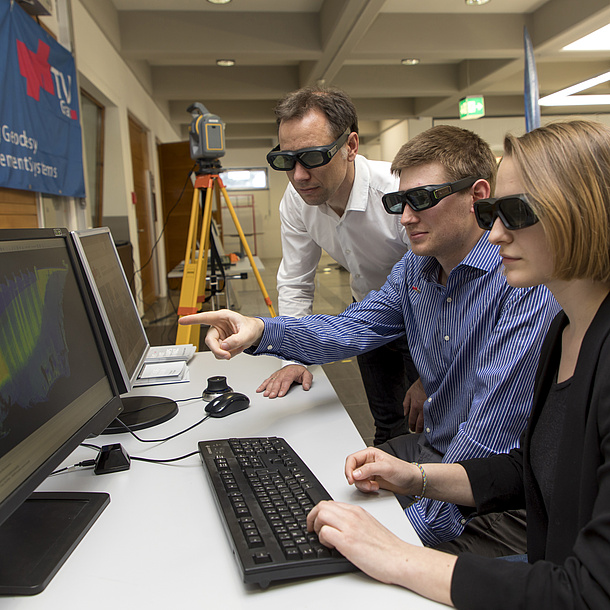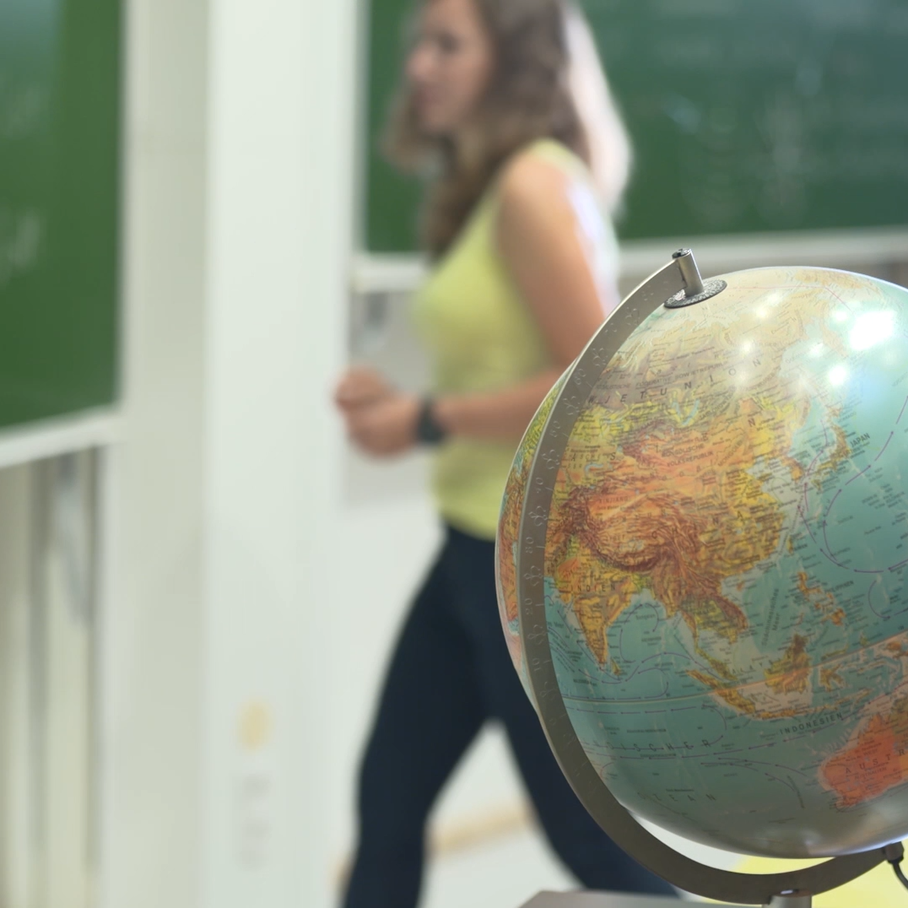Quick Facts
- Duration of study: 4 semesters
- ECTS credit points: 120
- Academic degree: "Diplom-Ingenieurin" or "Diplom-Ingenieur" ("Dipl.-Ing." or "DI"), equivalent to the Master of Science (MSc)
- Language of instruction: German, some courses in English.
The Master's Programme
In the Master's degree programme in Geodesy, you process and analyse Big Data in order to recognize people’s patterns of movement, control logistics processes for smart city applications and carry out environmental monitoring. In addition, you analyse measurement data to monitor structural features of infrastructure and landslides, as well as to avert (natural) disasters. You use satellite-based navigation technologies to control mobile machinery remotely. And you contribute to the development of new measurement systems and sensors.
The compulsory subjects Data Analysis and Reference Systems as well as Engineering Geodesy and Cadastre form the cornerstones of the degree programme. In addition, you can choose further specializations in the subject areas of engineering geodesy, satellite geodesy, navigation, remote sensing and geoinformation. The degree programme also prepares you for either setting up and running a business or pursuing an academic career. A methodological focus is placed on problem-based learning, which enables you to solve problems you may encounter in your profession.
The profession of geodesy has experienced a tremendous push toward modernization due to digitalization and the increased use of satellite technologies and Internet-of-Things (IoT) sensors. This degree programme prepares you to enter the current areas of activity in the subject and work with state-of-the-art technology. For this reason, the most modern infrastructure is made available to you at TU Graz, including laser scanners, drones, IoT sensor nodes, photogrammetric sensor technology and much more.
Focus Areas
You can specialize in the following areas:
Navigation: You learn how to measure the trajectory of moving objects and use global navigation satellite systems (GNSS) such as GPS or Galileo to do so. You develop navigation systems, e.g. for vehicles, pedestrians and drones – both for outdoor and indoor use – and employ sensor fusion methods during this development.
Physical geodesy and satellite geodesy: You observe and model the dynamic system of Earth in the context of global climate change. You process and analyse satellite data that ranges from data collected by instruments in space to those related to geophysical effects on Earth.
Engineering geodesy: You monitor landslides and control tunnel boring machines. You develop fully automated monitoring systems for use with bridges and dam walls. You capture the real world in high-resolution 3D and generate models for virtual reality and 3D printing purposes.
Land register: You work with the Austrian land register and learn about international land management. You provide information that establishes legal certainty in real estate matters. You assign value to properties, taking into account aspects of local spatial planning and construction law.
Remote sensing and photogrammetry: You collect valuable information about the Earth's surface with airborne and satellite sensors. Among other things, these data are used for environmental monitoring purposes and enable you to make valuable contributions to climate impact research. You use photogrammetric methods to conduct surveys, reconstruct objects from these surveys, create 3D models of buildings, or track changes in glaciers.
Geoinformatics: You collect spatial data for objects and phenomena on Earth and analyse and visualise these data using information technologies. You can establish spatial decision criteria by analysing large data sets, simulate future planning scenarios and harmonize large heterogeneous spatial data collections on-the-fly.

In the Master’s degree programme in Geodesy, I deepened my knowledge of navigation and satellite geodesy. Fortunately, I was able to conduct my master’s thesis work directly in the context of a current research project. I find the topic of combining different sensors, for example, to develop a robust navigation system for pedestrians very exciting and promising for the future.
Research
In the Institute of Geodesy at the TU Graz, we focus on the following areas:
Structural health monitoring: Structural health monitoring systems allow the health status of buildings to be assessed at any time. Automated early warning systems that indicate possible building failures increase the safety of residents and allow countermeasures to be applied in good time, reducing economic damage.
Resilient infrastructure: Geodesy enables the construction of so-called "resilient infrastructures" that react to external effects, such as floods, earthquakes and landslides. It also allows the creation of life-time digital twins, which enable users to predict the response of critical infrastructures, such as bridges, railway tracks, dams and tunnels, and apply optimization tactics.
Navigation platforms: Highly accurate reference trajectories are generated with vehicle-based navigation platforms. These are used to evaluate modern navigation sensor systems, such as GNSS receivers and antennas, inertial measurement units, imaging sensors and many more.
Change monitoring of System Earth: Among other things, this monitoring allows the influence of climate change to be assessed on many scales. At the global scale, the rise in sea level or changes over the entire land surface can be detected, natural hazard events can be monitored at the macroscale, and automated monitoring systems for critical infrastructure structures can be installed and operated at the local scale.
Geoinformatics key areas: These areas include geo-semantics, linked spatial data, spatial optimization, spatial agent-based simulation, and other current topics in geoinformation science. Applications can be found in the area of smart cities, the analysis of movement patterns, simulation of diseases and the evaluation climate change impacts on agricultural land.

I am proud to be part of a profession that can measure distances down to a few millimetres as well as distances across continents and oceans and even in the universe beyond the earth.
Nobody else can match our skills in this area!
Admission
1. Admission Procedure
Graduates of the Bachelor's Degree Programme in Geodesy at TU Graz are admitted without needing to fulfil any further requirements.
Admission without fulfilling further requirements is also possible if you have completed one of the following preliminary degree programmes:
- Geodesy and Geoinformation, TU Vienna
- Geomatics and Planning, ETH Zurich
- Geodesy and Geoinformation, University of Bonn
- Geodesy and Geoinformation, TU Darmstadt
- Geodesy and Geoinformation, TU Dresden
- Geomatics, HafenCity University Hamburg
- Geodesy and Geoinformatics, Leibniz University Hanover
- Geodesy and Geoinformatics, KIT Karlsruhe
- Geodesy and Geoinformation, TU Munich
- Geodesy & Geoinformatics, University of Stuttgart
Graduates of other bachelor's degree programmes can obtain information and apply for admission by contacting study@tugraz.at.
2. Admission
- Admission and deadlines for Austrian students who are beginning their studies at TU Graz for the first time
- Admission and deadlines for international students
- If you are or were already admitted to a degree programme at TU Graz, please come to the TU Graz Registrar’s Office in person during the admission period or contact study@tugraz.at.
Fragen zur Zulassung?
Contact study@tugraz.at
Career Prospects
Professional Fields
Precision and reliability are two of your core professional virtues. As a geodesist, you combine your knowledge of engineering and practical methods, as well as apply analytical thinking and strong problem-solving skills.
Your career prospects are excellent: You are in demand nationally and internationally wherever the terrestrial, aerial and satellite-based acquisition and interpretation of geodata are needed. Other fields of activity include developing new engineering geodetic measurement methods and providing geoinformation, positioning and navigation technologies.
For example, graduates work:
- as engineering consultants for surveying,
- as managers in technical offices,
- for energy supply companies,
- for major construction companies,
- for software development offices or at large technology companies,
- for surveyors in public offices, state and municipal offices,
- for service companies working with information technologies,
- for companies that manufacture geodetic instruments and various industrial companies and
- in science and research.



